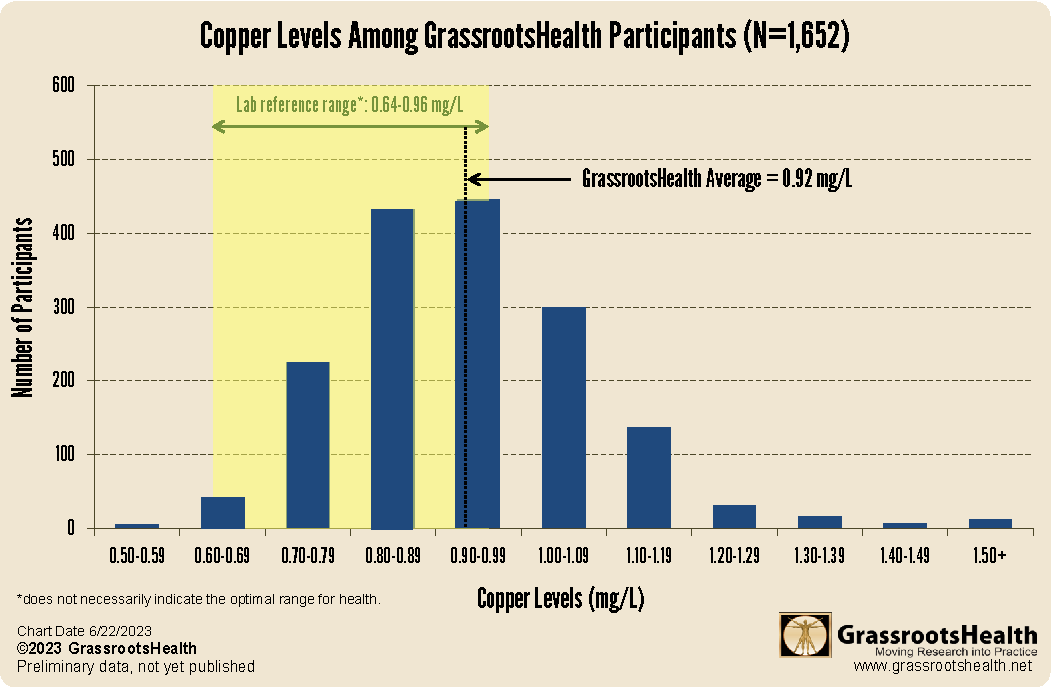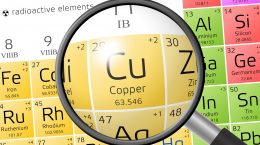Published on July 19, 2023
Anemia and connective tissue abnormalities can result from copper deficiency, a condition that can also be induced by excessive zinc intake
Key Points
- Copper is essential for the formation of collagen, a main component of connective tissue, and is therefore needed for heart and blood vessel function, skin integrity, wound healing, and bone strength; it is also necessary for iron absorption
- Copper deficiency can lead to anemia, neurological dysfunction, osteoporosis, and connective tissue abnormalities; those with a poor diet or with digestive disorders that limit absorption are at a higher risk for deficiency, and too much zinc intake can also lead to a copper deficiency
- The blood spot test from GrassrootsHealth provides the ratio of zinc to copper (Zn:Cu) along with copper and zinc levels; since too much zinc can inhibit the absorption of copper and lead to deficiency, it is important to know the ratio between these two essential elements
 Copper is an essential mineral that is present in all body tissues and is an important enzyme co-factor. It helps keep bones, skin, nerves, and the immune system healthy and working properly. Copper is essential for the formation of collagen, a main component of connective tissue, and is therefore needed for heart and blood vessel function, skin integrity, wound healing, and bone strength. It is also necessary for iron absorption, conversion to its useable form, and transport around the body.
Copper is an essential mineral that is present in all body tissues and is an important enzyme co-factor. It helps keep bones, skin, nerves, and the immune system healthy and working properly. Copper is essential for the formation of collagen, a main component of connective tissue, and is therefore needed for heart and blood vessel function, skin integrity, wound healing, and bone strength. It is also necessary for iron absorption, conversion to its useable form, and transport around the body.
Can you consume too little or too much copper?
Yes! The National Academy of Medicine recommends 900 micrograms (mcg) per day for adults (1000 mcg/day is recommended for pregnant women and 1300 mcg/day is recommended for mothers who are breastfeeding). Copper is found in a wide variety of foods including oysters and other shellfish, liver, beans, nuts, whole grains, potatoes, dark leafy greens, dried fruits, black pepper, yeast, and cocoa.
Copper deficiency is rare but can lead to anemia (due to iron’s dependence on copper for absorption), neurological dysfunction, osteoporosis, and connective tissue abnormalities. Those with a poor diet or with digestive disorders that limit absorption are at a higher risk for deficiency. Too much zinc intake can also lead to a copper deficiency. While a small amount of copper is essential to the body, toxicity can happen when excess intake occurs. Symptoms of copper toxicity include nausea, vomiting, abdominal cramps, headaches, and diarrhea, and can lead to liver and kidney dysfunction.
How is copper measured in the body?
Copper nutritional status can be assessed with a dried blood spot test. This test measures the amount of copper within the red blood cells as well as within the serum, and for this reason, can be more accurate and detect deficiencies earlier than a typical copper test of the serum alone.
In the spring of 2019, GrassrootsHealth started offering a copper test as part of the Elements Panel, which includes testing your vitamin D level along with essential elements magnesium, selenium, zinc, copper, and zinc:copper ratio, and toxic heavy metals cadmium, lead, and mercury. This test measures the amount of copper within the red blood cells as well as within the serum, and for this reason, can be more accurate than a typical copper test of the serum alone.
Copper Levels Among GrassrootsHealth Participants
Among the 1,652 participants who tested their copper levels, the average level of their most recent test was 0.92 mg/L which is in the higher end of the lab reference range (0.64-0.96 mg/L); this reference range indicates the range of typical results found in the population the lab serves but does not necessarily indicate the optimal range for health.
Excess Zinc Intake Can Induce a Copper Deficiency
Additionally, the blood spot test from GrassrootsHealth provides the ratio of zinc to copper (Zn:Cu). Since too much zinc can inhibit the absorption of copper and lead to deficiency, it is important to know the ratio between these two essential elements. The lab reference range for the ratio of zinc to copper (Zn:Cu) is 6.6 to 10.8. We will cover the latest results of this test in an upcoming post.
Make Sure You Are Getting the Right Amounts of Copper, Zinc, and other Essential Elements!
Do you know your selenium, magnesium, zinc, copper, and copper:zinc ratio levels? Make sure you know the status of these important elements and others with the Magnesium Plus Elements blood spot panel, and see if changes in your diet and supplementation could improve your element status and health outcomes. To know if you are getting enough, make sure you test today!
- Vitamin D
- Omega-3 Fatty Acids
- hsCRP
- HbA1c
- TSH
- Type 1 Diabetes Autoantibodies
Did you know that each of the above can be measured at home using a simple blood spot test? As part of our ongoing research project, you can order your home blood spot test kit to get your levels, followed by education and steps to take to help you reach your optimal target levels. Start by enrolling and ordering your kit to measure each of the above important markers, and make sure you are getting enough of each to support better mood and wellbeing!
Create your custom home test kit today. Take steps to improve the status of each of these measurements to benefit your overall health. With measurement you can then determine how much is needed and steps to achieve your goals. You can also track your own intakes, symptoms and results to see what works best for YOU.
Enroll in D*action and Test Your Levels Today!
How can I track my nutrient intake and levels over time?
To help you track your supplement use and nutrient levels, GrassrootsHealth has created the Personal Health Nutrient Decision System called

For each specific supplement, you can track what days you take it, how much, and many other details. This will help you know your true supplemental intake and what patterns of use work for you to reach and maintain optimum nutrient levels. Check it out today!







